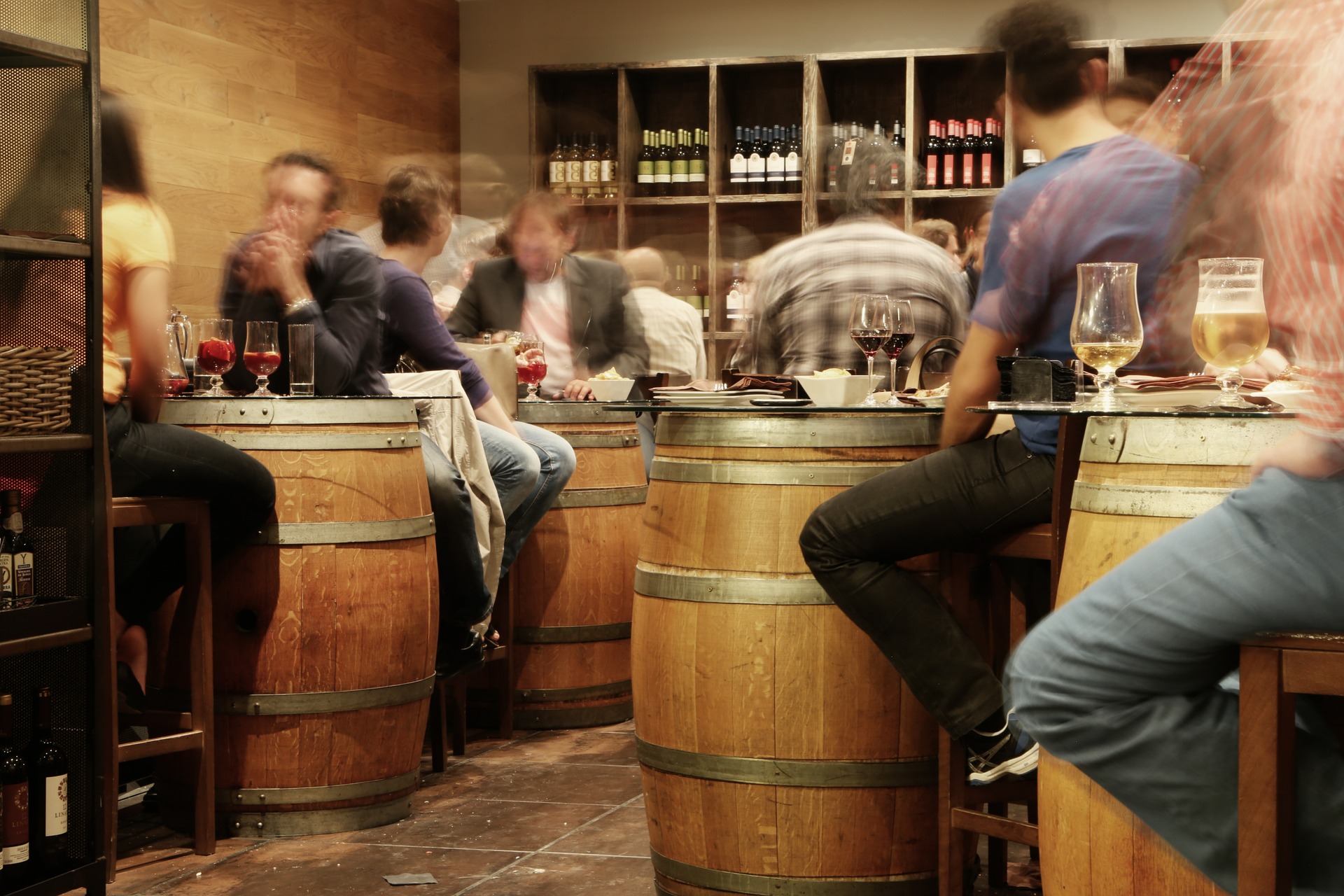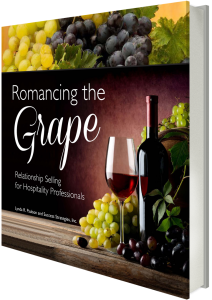Getting Creative in Wine Sales
These days wineries can no longer rely solely upon tasting rooms for all their direct-to-consumer (DtC) sales. It’s simply impossible to generate enough sales volume with the restrictions that may exist on visitor volume and tourism traffic.
In the 21st century, there are now numerous opportunities for making direct-to-consumer sales in and out of the tasting room:
- Winery Gift Shop
- Phone Sales
- Winery Special Events (aka pickup parties)
- Winemaker Dinners (when permitted)
- In-Home Tasting Events
- Internet Sales (website, social media)
- Video Conferencing (virtual tasting experiences via Skype or Zoom)
Would you like to capture as many DtC sales as possible via these venues? Let’s take a look at the opportunities:
Click on the ” + ” symbol to expand the content under each toggle below.
When guests are encouraged to wander around in the retail area, chances are increased they will buy accessories or logo items. Don’t you want them to go home with your winery’s logo on their baseball cap?
High-ticket items are the easiest to add on. Once your customer has purchased or intends to purchase several hundred dollars’ worth of wine, he or she is a perfect candidate for adding gifts and wine accessories––all you have to do is walk them over to the shop! Don’t be shy about this. Think of selling related items as a special service.
Your guests are customers, and they love to purchase souvenirs of their visits and gifts to bring home. Don’t miss out on these add-on and creative selling opportunities.
Why are your guests not directed to the shop? I believe it is because:
- You may be unfamiliar with the merchandise.
- You are not sure how to make the suggestion without seeming pushy.
- It is thought of as a self-serve area.
Here are some conversational ways to suggest that, after making their wine choices, that your guests browse in the winery shop:
- Walk up to guest with a big smile and say something like, “I see you are looking at our Pinot Noir glassware. These are made by Riedel, the best glassmaker in the business. Are you familiar with that company?”
- “Did you know that those purses are made of cork? They are unique, aren’t they? What a great gift for your friends at home.”
- “How do you like the design on that china? They are made in Italy. How do you like that type of art?”
Three comfortable phrases to get it started:
- I see you are looking at ___________.
- Did you know that _____________.
- How do you like _______________?
When your greeting or approach ends with a question, that asks for a response, and a nice conversation is started.
To make the most of your gift shop sales challenge, get to know the merchandise. Your retail sales clerk in the shop should be able to help you with this. Trust me, when you make add-on sales, that speaks volumes about your willingness to go the extra mile for your employers. You will be the hospitality host who really performs.
Tune Up Your Voice
- Smile: Make your phone calls in front of a mirror. You will soon see how your voice changes when you smile! Also, raise your eyebrows to create a positive, upbeat voice.
- Move Around: If at all possible, walk around while you talk, or if you can’t walk, try standing. You’ll find that gesturing and speaking with enthusiasm and vitality results in a fresh dimension of physical and emotional energy. You will come across as invested in your listener, conversational, and happy to be connecting with them.
- Match Their Style: Whether your customer is low-key, robust, playful or thoughtful, match their pace and tone; try not to be lower or higher than they are.
- Use a Check List: Outline your talking points, and keep your plan simple, so you remain spontaneous. Using a script with verbatim delivery will sound canned to your conversation partner, which will immediately turn them off. A list of talking points provides just enough preparation to help you keep the conversation going naturally.
- Chat: Having a real conversation is a great opportunity to build the relationship. Take advantage of their openness!
Take breaks from your phone calls. Walk around, stretch, and focus on other things for ten minutes.
Access Their History: If available in advance, check your customer’s buying and event history with the winery. (“Jane, I see you’re a big fan of Malbec from your purchase record. Would it be okay for me to tell you about our latest Malbec release?”) If you do not have their history, ask them, and make notes.
More Conversation
Keep the conversation going by mentioning the latest news about the wines or winery events, and be prepared with knowledge and details when they have questions. Use non-confronting lead-ins and soft-selling phrases like these:
- “Did you know about our new release of your favorite varietals?”
- “Let me tell you about something exciting (new) we are doing!”
- “You might want to consider a case. Shipping is discounted this month.”
How you make your customers feel with this phone call will give you the result you are hoping for. Remember . . . you are the winery!
Building Verbal Bridges
In a previous post, we discussed the importance of using bridges to tie together wine facts to their benefits for the consumer. With no physical language to help you “see” how the customer is reacting during your phone call, it becomes even more important to keep them continually engaged in your conversation to know their level of interest. That means less jabbering about facts and more conversational bridges to stimulate their verbal responses.
For every “fact” you convey, it’s important to engage their reaction. As you fine tune your phone delivery, you may find greater success by shortening up what you say as narrative so that you can elicit their response sooner:
- “We only made 300 cases of this wine this year. Would you like to be one of the few who gets to try this wine?”
- “I know you’ve purchased our Merlots in the past. This vintage is a real stunner. Does that interest you?”
- “I hate getting unexpected calls at home too. So let me cut to the chase since I want to respect your time, Bob. We only have 50 cases left of this library zinfandel. Should I put your name on a couple of bottles?”
Sales at winery special events isn’t too different from selling during your regular, tasting room experiences with a few exceptions: Most guests are already big fans of your wines. Most are already club member attending with the intention to pickup their current allotment. Here are a couple of tips to increase sales:
- Review the guest list ahead of the event to learn if any guests are your “regulars.”
- Review guest product pick-up list to coordinate with those you already know. Is “Jane” not picking up her usual Chardonnay this time? Could you inquire about that “oversight” if you see her at the event? Will a new bottling become available at the event that club members didn’t have available to them ahead of time to choose that you could upsell?
- Note non-member guests that might be converted to club members or purchases. Can you offer assistance in letting them taste a wine? “Bill, I’ll be at the XYZ table if you’d like more information about our club memberships. I’d be happy to take the time to provide the details while you’re here.”
Most winemaker dinners are relaxed, informal events that omit on-the-spot sales. However, when possible, this is an ideal time to ensure guests are aware they may make purchases, if desired.
These events are an ideal time for guests to get to know the winemaker and the stories behind each wine served. If you can find out ahead of the event what stories or information the winemaker will be relaying to guests, you’ll have an opportunity to prepare your own stories, if asked.
As the event is built around food and wine pairing, this is the best opportunity for you to craft your own wine and food pairing stories around the wines being served. Stories around how many acres are grown of XYZ wine, or how many tons of grapes were harvested from that block, will draw far less interest from guests than your story about sharing the wine with “Aunt Julie” a couple months ago, paired with butternut squash soup.
Your best bet is to act the host and ensure guests feel comfortable and are enjoying the dinner party.
These events are often limited by state licensing and permits if you are selling wine on site. They can be similar to winemaker dinners or be more casual, sitting around a host’s living room or patio while enjoying the wines.
Sales may be setup to take order for future wine delivery—no wine changing hands at the event.
Selling at an in-home event may be very similar to selling in your tasting room with a few exceptions:
- You may be a guest in the host’s home. Be mindful of their personal rules and defer to their cues about how much time you should talk versus allowing the guests to chat among themselves. Your event structure may be quite different from the structured experiences in your tasting room.
- Be well prepared to handle drips and spills. As wine easily stains upholstery and carpeting (that may not be present in your tasting room), you must be extra careful when pouring samples for guests.
- Plan out and rehearse in your head the mechanics of sharing your wine ahead of the event so that you’re not distracted by the different venue while you talk about the wines. In-home events often include pouring across a low coffee table or other furniture that wouldn’t be present in your tasting room. You may also not have adequate surface space to display all your bottles as you would back in your tasting room. Be sure to have a strategy to ensure guests can see each bottle when it’s shared to make the best impression.
- If planning to accept online orders at the event, ensure your wifi or hotspot access is working well before the event begins so that there are no surprises about lack of cell service at your venue location.
Most internet sales on your winery’s website or social channels are managed by your marketing department, removing the sales experience from your control. However, it’s important for you to remain familiar with how sales are completed on your website so that you can help customers. You may hear, “Jean, I tried to order that Marsanne you mentioned, but I had trouble with the online ordering system.”
- Be prepared to either provide assistance yourself or connect your guest with someone from web support who can assist the customer.
- Do you follow your own winery’s social channel pages?
- Do you think your winery would benefit from holding “takeover” days on their social media pages with tasting room staff from time to time?
- Have you thought of a better/faster way for customers to make their purchase on your website? Share it with the technical staff.
Until recently, winemaker dinners and tasting events were limited to in-person events. With current technology, more and more wineries are venturing into virtual tastings. This may be a tweet chat on Twitter, or a winemaker tasting conducted via Skype or Zoom.
- Can you offer virtual tastings with club members or guests using these tools?
- What technical considerations must you plan for besides getting the wine to both parties?
- What lighting or audio pitfalls do you need to plan in advance for so that there are no hitches in the event?
- Does it help to create a large diagram or map on the wall behind you for your virtual guests to see on screen?
- Do you need to craft written collateral to accompany the wines when sending supplies to your virtual guests?
- Will you have a way virtual guests can make a purchase at the end of the event?
Creative Selling Conclusions
Creative selling requires preparation and planning. Determine which creative venues and projects you’ll tackle. Make a list of your strengths and weaknesses. If phone sales are intimidating, consider conducting virtual tasting events.
Take notes of what does and doesn’t work along with what new tools are required in order to implement a new tasting event. Make adjustments as you go. The more you can work closely with your sales and marketing team, the more successful you will become at generating more DtC wine sales.
This article is part of the email Relationship Sales Success Series. It provides a step-by-step guide to improving wine sales and wine club sign ups. While it focuses upon techniques for those working winery tasting rooms, the principles of great sales skills can apply to any industry. Sign up for the series here.





